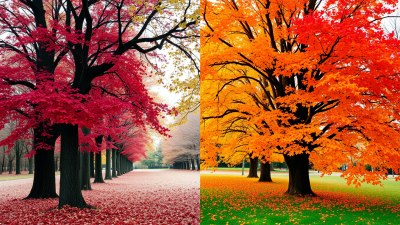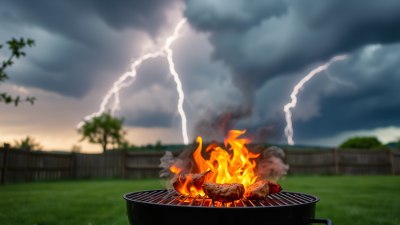What Your Favorite Season Says About Your Attachment Style
Discover how your favorite season reveals key insights about your attachment style and emotional patterns in relationships.

Image created with Flux Schnell
Our preferences often speak volumes about our inner world, even when it comes to something as simple as favorite seasons. Beyond the weather, colors, and activities we enjoy, the season we gravitate towards can mirror our deepest emotional tendencies, particularly our attachment style. Psychologists have long studied attachment theory to understand how early relationships with caregivers influence our adult relational patterns. By exploring the link between seasonal preference and attachment, we can gain new insights into how we connect, communicate, and seek closeness with others.
Attachment styles are generally categorized into secure, anxious, avoidant, and disorganized, each representing distinct ways of relating to others emotionally. These styles shape how we handle intimacy, trust, and conflict in relationships. Interestingly, each season embodies certain symbolic elements and environmental cues that resonate differently with these attachment orientations.
The Basics of Attachment Theory
Before diving into how seasons correspond to attachment styles, it's important to understand the foundational concept of attachment theory. Originally developed by John Bowlby and expanded by Mary Ainsworth, attachment theory suggests that early interactions with caregivers form internal working models about ourselves and others. These models influence expectations and behaviors in adult relationships.
Secure attachment individuals typically experienced consistent, responsive caregiving. They are comfortable with intimacy and autonomy, expressing emotions openly and trusting others.
Anxious attachment
Avoidant attachment
Disorganized attachment
Why Seasons Matter in Personality and Emotions
Seasons are more than meteorological phenomena; they represent cycles of growth, rest, change, and renewal. Many cultures and psychological systems associate seasons with specific moods, colors, and energies. For example, spring is linked to rebirth and optimism, summer to warmth and vibrance, autumn to harvest and reflection, and winter to rest and introspection.
Preferences for certain seasons can reflect our emotional needs and how we relate to the world. The environment also triggers physiological and psychological responses — light exposure impacts mood regulation, temperature influences energy levels, and social rituals tied to seasons affect how connected we feel.
Spring and the Secure Attachment Style
Those who favor spring often embody characteristics echoing secure attachment. Spring’s themes of renewal, fresh starts, and blossoming growth parallel the secure individual's ability to embrace vulnerability and growth in relationships. The brightening days and moderate temperatures invite socialization without overwhelming intensity, much like secure attached people’s comfort with balanced closeness and independence.
Securely attached individuals tend to approach relationships with optimism and flexibility, traits that spring's hopeful vibe enhances. They enjoy new experiences, much like how spring brings new life after winter’s dormancy. This season also symbolizes emotional warmth and openness, mirroring secure attachment’s hallmark of emotional accessibility.
Furthermore, the moderate weather allows for consistent interaction without extremes, paralleling how secure individuals handle emotional highs and lows with steady regulation. Spring’s sense of growth aligns with their focus on personal development and mutual support in relationships.
Summer and the Anxious Attachment Style
Summer, with its intense heat and heightened activity levels, can symbolically reflect the anxious attachment style. Those drawn to summer’s vibrancy may crave intense connections and emotional warmth but also experience inner turmoil driven by fear of rejection or abandonment, much like summer’s fluctuating and sometimes overwhelming nature.
Anxiously attached individuals often seek reassurance and closeness, paralleling summer’s communal events and social gatherings. The bright, extended days foster heightened social interaction, reflecting how anxiously attached people desire continuous connection but may struggle to feel secure.
However, summer’s extremes can also represent the emotional volatility experienced by the anxious style. Just as summer heat can be draining or invigorating, anxiously attached people oscillate between affection and anxiety. Their heightened sensitivity to social cues mirrors summer’s sensory intensity—loud noises, bright lights, crowds.
Moreover, summer’s peak season reflects the anxious person’s urgency to achieve emotional security, craving a 'high point' in relationships that assuages their doubts. Yet, this intensity can sometimes exhaust both themselves and their partners, analogous to how summer’s heat can become overwhelming.
Autumn and the Avoidant Attachment Style
Autumn’s qualities of transition, shedding, and solitude correspond closely to the avoidant attachment style. People who favor autumn may appreciate reflection, independence, and the quieter moments before winter’s arrival, echoing avoidant individuals’ preference for emotional distance and self-reliance.
The symbolic falling leaves represent letting go, much like avoidant individuals tend to suppress emotional needs and detach to protect themselves from vulnerability. Autumn’s cooler, shorter days invite introspection and personal space rather than social intensity, aligning with the avoidant’s tendency to minimize closeness.
Furthermore, autumn’s focus on harvesting the fruits of labor signifies avoidant people’s preference for controlled, practical engagements over emotional risk-taking. The season’s beauty paired with an undercurrent of decay mirrors how avoidant individuals may appear charismatic yet keep others at arm’s length.
Autumn also signals preparation for winter, a time of solitude and self-protection, much like the avoidant’s emotional self-containment. The avoidance of overwhelming summer heat can be seen as analogous to their avoidance of emotional intensity.
Winter and the Disorganized Attachment Style
Winter’s stark landscape and inherent contrasts between cold harshness and quiet stillness align with the disorganized attachment style’s conflicted and often chaotic emotional experience. Individuals attracted to winter may resonate with its contradictory nature—both comforting and isolating, harsh yet peaceful.
Disorganized attachment is characterized by confusion, fear, and difficulty integrating emotional experiences. Winter’s unpredictability—icy surfaces, early nights, fluctuating moods—can metaphorically reflect this internal turmoil. The season’s solitude may appeal due to a desire for safety but may also amplify feelings of abandonment and uncertainty.
The bleakness of winter, combined with occasional moments of serene beauty, parallels disorganized individuals’ vacillation between seeking connection and pushing others away. Much like the season’s extremes in weather can be disorienting, disorganized attachment reflects an inconsistent and fragmented approach to relationships.
However, just as winter holds the promise of eventual spring, the disorganized style carries the potential for healing when supported by understanding and therapeutic intervention. Those drawn to winter might be more introspective or aware of their relational struggles, which can be a first step toward integration.
How to Use Seasonal Awareness in Personal Growth
Identifying your favorite season and its connection to your attachment style is not about limiting yourself but rather about gaining perspective on your emotional patterns. Understanding these symbolic associations can promote self-awareness and guide efforts toward healthier relationships.
If you identify with a season linked to a less secure attachment style, this awareness can motivate you to cultivate traits associated with secure attachment—such as trust, emotional regulation, and open communication. For instance, an anxiously attached 'summer person' might practice mindfulness to temper emotional intensity, while an avoidantly attached 'autumn person' might work on opening up to others gradually.
Moreover, incorporating seasonal metaphors into therapy or self-reflection can be powerful. Visualizing emotional states as seasonal changes helps normalize fluctuations and frames growth as a natural cycle rather than a failure. This perspective encourages patience and resilience.
Engaging with the qualities of seasons that contrast your attachment tendencies can also promote balance. For example, if your favorite season is autumn with avoidant tendencies, embracing the sociability of summer or the renewal of spring can expand your emotional range.
Seasonal Activities to Support Healthy Attachment
Engaging in activities aligned with your favored season can support emotional health and relational growth, especially when combined with an understanding of your attachment style.
Spring: Try planting a garden or attending community events that emphasize growth and connection. These reinforce secure attachment traits of openness and trust.
Summer: Focus on social activities that foster positive interactions but set boundaries to manage intensity. Practices like group sports or festivals can satisfy social needs without becoming overwhelming.
Autumn: Take time for solitary creative endeavors such as writing or crafting, balanced by selective social gatherings. This supports avoidant individuals in expressing themselves while remaining self-reliant.
Winter: Use the quiet time for deep introspection, journaling, or therapy, complemented by gentle social support. Mindfulness and relaxation techniques can help mitigate disorganized attachment’s inner confusion.
Variations and Cultural Perspectives
Attachment styles and season preferences may also be influenced by cultural backgrounds and geographic location. For example, in regions with less pronounced seasonal changes, other environmental or social factors might play bigger roles in emotional expression and relationship patterns.
Cultural celebrations tied to certain seasons can also shape emotional associations. A culture that celebrates festivals during winter might imbue that season with warmth and connection rather than isolation. Similarly, socioeconomic factors that dictate how people experience seasons can affect their emotional resonance.
Therefore, while seasonal preferences offer insightful clues about attachment styles, they should be considered within a broader personal and cultural context to fully understand their significance.
Recognizing Shifts Over Time
It’s important to acknowledge that attachment styles are not static, and preferences such as favorite seasons can change over time due to life experiences or emotional growth. For example, someone who favored the isolating qualities of winter in youth may gradually appreciate the renewal of spring as they heal from past traumas.
Life transitions, therapy, and supportive relationships often encourage movement toward secure attachment traits. Similarly, exploring new seasonal environments or engaging in unfamiliar seasonal activities can broaden emotional horizons and influence seasonal preference.
This fluidity is encouraging, reminding us that our emotional and relational selves are adaptable and capable of growth.
Attachment, Seasons, and Interpersonal Dynamics
Recognizing how attachment styles and seasonal preferences interplay can also improve interpersonal relationships. Couples, families, and friends can enhance understanding by sharing their emotional climates metaphorically through seasons, facilitating empathy and communication.
For instance, a partner who identifies as a 'summer' person with anxious attachment can explain their need for reassurance during emotionally hot moments, while an 'autumn' avoidant may express their need for solitude clearly. Such dialogue creates space to honor differences while nurturing connection.
Workplaces and social groups may also benefit from acknowledging these dynamics. Scheduling activities and recognizing varying social needs based on these symbolic preferences can improve cohesion and reduce misunderstandings.
Practical Exercises to Explore Your Seasonal Attachment
To deepen your connection to your favorite season and attachment style, try the following exercises:
- Journaling: Reflect on how the qualities of your favorite season mirror your relational behaviors and feelings. Write about times you felt emotionally aligned with that season’s vibe.
- Nature Walks: Spend time outdoors during your favorite season, observing how the environment influences your mood and social interactions.
- Creative Expression: Use art, music, or writing to express your emotional experiences linked to that season.
- Attachment Inventory: Take an attachment style questionnaire to compare your results with your seasonal preferences for deeper insight.
- Therapeutic Exploration: Discuss these themes with a therapist to uncover subconscious patterns and develop healthier relational strategies.
Bringing It Into Daily Life
Understanding your attachment style through the lens of your favorite season can be an ongoing tool rather than a one-time revelation. Incorporate this awareness into daily life by noticing mood shifts aligned with environmental changes and using seasonal metaphors to navigate relationship challenges.
For example, when feeling emotionally 'summer-hot' with anxious worries, remind yourself of spring’s steady growth or autumn’s cooling detachment to regain balance. If winter’s isolation threatens to overwhelm, seek out social 'springtime' experiences to rekindle connection.
Ultimately, this framework encourages holistic self-awareness, integrating emotional, environmental, and relational dimensions for richer self-understanding and interpersonal harmony.
Embracing your favorite season as a window into your attachment style enriches your journey toward emotional authenticity and relational fulfillment. It invites you to honor your unique rhythms while inspiring growth toward secure connection, no matter the season of your life.











